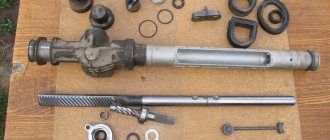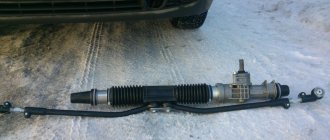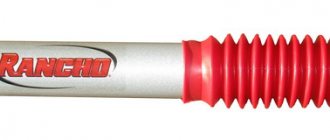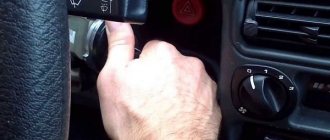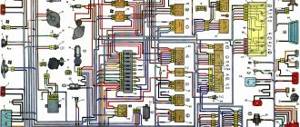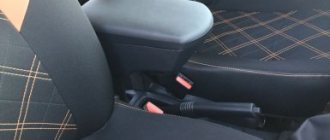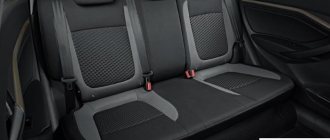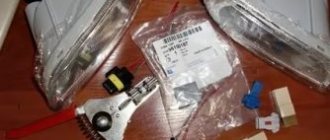Increasingly, car owners began to install a sports steering wheel in their cars. It looks very impressive and beautiful. In addition, such tuning increases driving comfort and convenience. But experts contradict this statement, considering the sports steering wheel dangerous to life, justifying this with real reasons.
Advantages
To understand whether you should install a sports steering wheel or leave the factory device, you need to consider all the advantages and disadvantages of the first. The advantages of such tuning include the following points:
- Small dimensions improve driving comfort for tall and overweight drivers.
The sports steering wheel has special recesses for the hands, which allows you to firmly hold the control and prevent your hands from slipping.
Impressive appearance. Especially in sports-type models, this steering wheel looks very good.
It makes driving a car very easy. This steering wheel is lighter than the original one and allows for good cornering.
The owner can remove and take it with him, preventing theft of the car.
Flaws
The disadvantages include the lack of security that comes with a factory part. The fact is that sports type ones are made of metal. In the event of an accident, the driver will suffer significant damage. The factory device is made taking this factor into account and softens the blow. There are parts inserted into the steering wheel that, when subjected to strong impact, are crushed, which practically does not injure human tissues and bones. In addition, the design of the sports steering wheel is not included. And in the event of an accident, the driver can crash or receive serious injuries.
The next drawback is the difficulty when turning. A small radius forces you to exert more effort, which is sometimes insufficient on a slippery road. This can lead to an accident or skid.
Due to their structure and size, many sports steering wheels block the instruments on the panel, which causes inconvenience. And it is almost impossible to purchase a part for tuning of large sizes, only if it is made to order.
Passing inspection with such a steering wheel will be problematic. According to the rules, driving a car is only possible with a standard device. To complete the required procedure, you will have to install the old car steering wheel again.
Installing a sports steering wheel will require purchasing an additional adapter, which means extra expenses. In this case, you will have to look for a suitable device depending on the car model. And the installation itself is now quite expensive.
Conclusion
Thus, the sports steering wheel is inferior to the standard one in safety, but wins in appearance. However, if you want to make tuning and change this part in the car, then it is better to choose a classic version with non-standard upholstery. And be sure to check the quality certificate so that in the event of an accident the steering wheel does not become a killer. Very often, counterfeits appear on the market and are not manufactured to the required standards. Such a steering wheel can easily fail and impair control.
Installing a sports steering wheel in your car is one of the stages of tuning. The sports steering wheel improves vehicle handling and reduces driver fatigue in difficult driving conditions due to its more sophisticated ergonomics compared to the standard steering wheel. But installing a new steering wheel requires knowledge of some installation nuances.
We begin the installation by removing the old steering wheel. First of all, disconnect the battery from the on-board network. Then remove the decorative horn trim. It can be attached either with hidden latches or with hidden screws from the rear of the steering wheel. Under the trim there is a contact group for the horn and an airbag. We disconnect the switching connectors from them. After unscrewing the four screws, carefully remove the airbag module from the steering wheel. In the depths of the niche, the central nut of the steering wheel fastening on the steering shaft becomes visible. We fix the steering wheel in a stationary position and use a socket wrench with an extension to unscrew the central nut. The fit of the steering wheel on the shaft is very tight; it is not possible to remove it by hand. This requires a special puller. We install the puller strictly according to the instructions and tighten the screw shaft until the steering wheel is removed from the spline connection. That's it, dismantling is complete. There are two types of sports steering wheels - designed for installation on a specific car model and universal. There are no difficulties when installing steering wheels for a specific car model. All seats and switching connectors match in them. You just need to put everything back together in reverse order. After assembly, connect the battery terminal and check the functionality of all the buttons on the steering wheel. Pay attention to the airbag malfunction indication on the dashboard. If connected correctly, it should not light up. Installing a universal steering wheel is more problematic. The first thing you need is an adapter designed specifically to install this steering wheel on your car model. It is advisable to use adapters from well-known manufacturers, such as Momo, Sparco, Nardi. Your safety depends on their quality of manufacture. During installation, the adapter is first attached to the steering shaft, and then the steering wheel itself is attached to it. All required fasteners must be included with the adapter and handlebar. Do not use general purpose bolts, studs or nuts - the steering uses heavy-duty fasteners. After installation, connect the horn connector and insert the decorative plug. We connect the battery terminal and check the functionality of the sound signal. That's it, you can go. When installing a universal sports steering wheel, keep in mind that some functions of the standard one will be lost. The most important thing is that you lose your airbag. It’s simply not in the universal steering wheel. And the airbag crash indicator lights up on the dashboard. It will be necessary to make a special “decoy” to bypass the controller. It is better to entrust this to a specialist, because... there is a risk of damaging the controller and, accordingly, blocking the operation of all other airbags. You also lose all the functions of the service buttons on the standard steering wheel - cruise control, audio system control, telephone control, etc. In some cases, the automatic return to the original position of the turn signal switch stops working.
New sports steering wheel for a car
Install a sports steering wheel
Replacing a standard steering wheel with a sports one changes not only the appearance of the interior and the driver's position, but also helps you hold on to the steering wheel more confidently. This is facilitated by the ergonomics of the steering wheel, its upholstery with high-quality materials, and the ability to choose a convenient diameter. And to install a sports steering wheel in most cases, a special adapter (adapter) is required. Each car model requires a specialized adapter.
For most cars, a special adapter is required to install a sports steering wheel. It is recommended to purchase special safety adapters of the SPARCO standard. Such an adapter absorbs part of the energy upon impact, partially reducing the likelihood of injury. Finding an adapter for a less common production model can take quite a long time.
Before starting any work, set the front wheels straight. This can be done by driving for some distance at low speed while holding the steering wheel. Remove the negative cable from the battery.
Before you begin removing the old steering wheel, locate the airbag control module if your vehicle is equipped with them. You can determine the location of this module according to the instructions for the car. On this module, locate and disconnect the multi-pin connector and insulate it. This operation will disable the airbag deployment while the work is being carried out.
Remove the old steering wheel. Unscrew the signal plate from the old steering wheel and screw it to the adapter. Route the wires inside the adapter. Make sure that the contacts touch each other when you turn the steering wheel. If this does not happen, the sound signal will not perform its functions.
Then install the steering shaft adapter, but finally tighten it only after the steering wheel is level. In other words, just “bait” it.
You can level the steering wheel on a straight, free platform. To do this, move straight forward for a while and then back up. At the same time, install the steering wheel straight, if necessary, removing the adapter and installing it again with an offset. After this, secure the adapter completely.
The sports steering wheel itself is attached to the adapter with special screws, which should be included in the kit along with the adapter or with the sports steering wheel. Connect the horn button.
According to the Road Safety Act, it will be very difficult to pass inspection in a standard car with a sports steering wheel.
Consult with the seller regarding the choice of adapter (adapter). It must be guaranteed to fit the selected type of car. This guide will help you install a sports steering wheel on your car and think about the feasibility of installation.
Hyundai Sonata 6 review and price of the car Suzuki Grand Vitara review, video test and photo of the interior BMW x 1 review, characteristics The best sports car of 2011 Ferrari Italy 458
This device was essentially developed and implemented initially in professional racing (rally, F1). Since I like to find my pros and cons in everyone, let’s think and voice:
- Saving space in the car.
- Improved maneuvering at high speeds thanks to the small diameter.
- They have rider safety certificates (does not apply to “sports steering wheels” from our markets).
- Well, and most importantly, the beauty is not childish...
Well, it seems like all the advantages. Now let's move on to the negative side of sports steering wheels.
- The first and biggest drawback is that a very large part of sports steering wheels are cheap and low-quality fakes. This can lead to very bad consequences in an accident. Personal experience suggests that with a sports steering wheel it is more difficult to turn on the spot due to its small diameter.
- In VAZ cars, when installing a sports steering wheel, such an important function as automatic turn-off does not work.
- The need to purchase an additional adapter for installation.
- It is possible that you will not pass the technical inspection.
- High rigidity in case of an accident.
Here we briefly talked about the advantages and disadvantages. In my opinion, the motives for installing sports steering wheels are their beauty and “show-off” compared to a standard wheel. The steering wheel of the classic VAZ is thin and uncomfortable, unreasonably large, but on the other hand it is safer than a cheap Turkish-Chinese fake. As for safety, it is up to each person to decide separately. And, based on this, make a choice whether YOU need it, lean towards one or another manufacturer.
Our brother’s wallet is not always full of coins and therefore I would like to briefly consider a budget option for those who still decide to install it.
Bicycle steering column
The steering column is usually called a set of elements (in particular cups, rings, boots, anchors, etc.) containing open or industrial (closed) type bearings. It is the steering column that ultimately ensures the rotation of the steering wheel and fork and is responsible for the smoothness of this process and the durability of maintenance-free operation. Choosing a suitable and most importantly compatible steering column for the existing frame glass is extremely important for its successful installation and good steering performance in general, in particular: steering responsiveness; smoothness and softness of rotation; endurance of the entire assembly to certain loads; absence of gaps and backlashes; increased durability.
Among all existing steering columns, there are two main different types:
- Threaded steering column. An inevitable relic of the past and, in a sense, a “classic”, well known to many as practically the only option used for bicycles originally from the USSR. Simple and straightforward to install and remove, unpretentious and cheap, but at the same time it is far from the most reliable and not intended for increased loads.
Nowadays, although it is obviously outdated along with other options, it continues to be persistently used by manufacturers on recreational and road bicycles, as well as on cruisers.
In general, this choice is justified, since for the listed disciplines there are practically no serious loads on this unit and the requirements for it are minimal. The threaded steering column includes upper and lower cups, which are installed into the frame glass using a press-fit method. The thread, as the name suggests, is present on the fork stem (therefore, such a steering column requires a special fork with a thread applied and a certain length of the stem), it is intended for tightening the upper cup, which is also threaded on the inside. From above, the structure is additionally fixed and finally tightened with a lock nut, subsequently firmly holding the fork rod in the steering tube. Bearings (regardless of type) are traditionally placed inside the upper and lower cups.
A threaded steering column is clearly recognizable externally during a visual inspection by the characteristic lock nut in the upper part of the steering tube; this design is also distinguished by the most impressive size of the protruding parts (in height relative to the edge of the tube tube) beyond the frame. A threaded steering column can also be semi-integrated, when the bearing cups are recessed inside the steering tube of the frame, and only the outer edge of the upper cup and the locknut remain visible on the surface. As such, such a design does not have any advantages precisely in the execution of such an outdated solution, and the presence of external protruding threaded elements reduces all the advantages to nothing.A significant difference between a threaded steering column and other types is that the fork stem should not be significantly longer than the height of the steering tube (the protruding part is fixed in size), and after fixing the fork with the help of the steering column cups, there are no protruding parts. In this case, the fork is securely clamped inside the glass without installing a stem, which no longer has any effect on holding the entire structure together. Despite the simplicity of the mechanical part of the threaded steering column, it has a number of significant disadvantages. This type of steering wheel is quite difficult to accurately adjust and fit all parts without backlash and gaps, and also requires a certain skill during assembly and a set of specific tools for maintenance.
Threaded steering arms are also often characterized by greater weight of the entire structure compared to available analogues. But the main drawback lies in the general structural unreliability, since steering wheels of this type are not only not designed for increased loads, but even over time they unwind and become loose even in quiet recreational riding. The threaded column also has advantages, for example, an external handlebar stem of arbitrary length and shape, which allows you to adjust the height of the handlebars over a larger range, as well as the use of designs of complex, sophisticated curved shapes that provide additional comfort and convenience, which is more relevant specifically for pleasure-type bicycles and bicycles. . - Threadless steering column. The most common and most successful standard, used for most modern bicycles, including those used in extreme and most loaded riding disciplines.
It is distinguished by ease of installation, often high quality of its components and unpretentiousness during operation.
It also does not require special adjustments or adjustments, since the structure fits neatly into the grooves and is evenly tightened by an anchor inside the pipe. The threadless steering column also includes two cups, upper and lower, which house bearings regardless of type. The cups do not have a thread and are installed into the frame glass using the press-fit method. To pull the structure together and hold the fork rod in the frame, a combination of: a special anchor is used, which is placed in the fork rod and opens there, centering and aligning the position of the cups and rings relative to each other;
and the steering stem, ensuring final and reliable tightening (it is the fastening and fixing of the stem that plays the decisive role in reliably holding the fork in the frame. The good thing about a threadless steering column is that in some variations of the design it has virtually no elements protruding beyond the limits of the steering tube, which allows for maximum lower the handlebars to the frame if necessary.This design is considered the most reliable and at the same time allows for the softest and smoothest steering without sacrificing increased safety. Threadless steering columns are most often used in modern mountain bikes for a wide variety of purposes - from light cross-country to serious downhill or dirt jumping, allowing the full potential of a two-wheeled device to be revealed.
Columns of this type have almost no drawbacks, except for some restrictions on the height of the handlebars, which is in demand in a number of cases, which is why such handlebars are less often used for traditional road and recreational bikes. Otherwise, this non-alternative and largely uncompromising technological solution is distinguished by exceptional convenience, unpretentiousness, high quality and increased thoughtfulness.
Installing a sports steering wheel on a VAZ.
To install a sports steering wheel on a VAZ, we will need:
- The steering wheel itself.
- Adapter (it is different for different models).
- Set of tools.
The first step is to disconnect the vehicle's ground. Next you need to remove the steering wheel. Read how this is done here. Now you need to disconnect the signal plate from the steering wheel and connect it to the adapter, guide the wires inside. Important point!!! You need to make sure that the contacts touch the rings, otherwise you can forget about the signal.
Well, the only thing left to do is to grab the steering wheel with a couple of screws and on a level surface determine the level position when moving straight. Don't forget to tighten the remaining nuts. The description of the adapter says that in the event of an accident, it crumples and absorbs some of the energy. It's up to you to decide... At this point, the installation of the sports steering wheel in the VAZ is completed, thank you for your attention.
When buying a sports steering wheel, you should pay attention to some characteristics. One of them will be injury safety. In the event of an accident, the steering wheel should be sufficiently deformed, thereby causing the least harm to the driver. In addition, you will have to abandon the airbag, since it is not provided for in sports steering wheel models. But there are special adapters that can to some extent replace the airbag.
It is also worth noting that a sports steering wheel for the Lada Kalina can be used as a new steering wheel.
No less attention should be paid to the size of the steering wheel - the smaller the steering wheel, the more difficult it is to control the car, there are known cases of power steering failure when driving off-road, and not everyone can handle driving with a small steering wheel, but for adrenaline lovers it will do just fine. And for a more relaxed driving, you should choose a steering wheel like a rally car. For those who support comfortable and safe driving, a unicycle would be the best option.
Subtypes of threadless steering columns
Threadless steering columns themselves are divided into three main types, the differences of which are significant in many ways and must be taken into account when choosing for compatibility with the frame’s steering tube:
- Standard threadless steering column with external cups. Symbolic designation of such a helmsman EC (External Cup). The most common case of threadless headset is used for mountain and road bikes of various types.
The headset is often called Aheadset after the name of the brand that first introduced this standard to the bicycle market. This steering wheel is different in that the cups with bearings are located outside the steering tube, outside of it.
This design is more unpretentious and less expensive compared to analogues, however, the cups protruding outward affect the distance from the steering tube to the stem, making it impossible to reduce the height of the stem, and also, purely aesthetically, sometimes look very controversial.
Otherwise, the standard threadless steering column is a high-quality, well-designed product with virtually no flaws. Cups with bearings are pressed into the steering tube of the frame, and the bearings can be changed in case of wear. Afterwards, the fork, together with the steering stem, is aligned/tightened with a special anchor and a thrust ring, and finally the main fixation of the entire structure occurs with the stem mount. - Semi-integrated threadless steering column. Symbolic designation of such a helmsman Zerostack (ZS). The name “semi-integrated” comes from the word “integrate,” meaning “to build in.” Thus, the solution for a semi-integrated steering column is as follows: two cups (upper and lower) along the inner diameter of the steering tube are pressed inside, leaving practically no protruding parts on the surface, with the exception of the outer ring of the cup or rubber boot.
This is also why such steering columns are often called “Zero Stack”, which means “Zero Lift”. Another popular name for “Low Profile” is “Low Profile”. Thus, the design is ideologically similar to an ordinary threadless column, differing only in the direct location of the cups with bearings inside the glass and, of course, the size of the bearings themselves in the final analysis.
This design is more complex and delicate to manufacture, therefore it costs more than standard aheadset handlebars and is more often used in more professional bicycles for narrow purposes. The main advantage of this type of steering wheel is that the virtual absence of protruding elements from the frame glass allows you to lower the handlebar stem as low as possible (literally press it to the frame), which is sometimes necessary for certain cycling disciplines (for example, road and downhill), including giving greater strength to the steering unit.
This arrangement of the steering elements also contributes to a more correct aerodynamic landing, improving the overall geometry of the rider in conjunction with the bike. - Integrated threadless steering column. Symbolic designation of such a helmsman Integrated (IS). Finally, the most professional implementation, designed to completely “recess” the steering wheel into the frame and literally merge them into a single whole. As the name suggests, it is the integrated (built into the glass) steering column that ensures such a merger. The essence of the implementation remains the same, only it is not the cups that are pressed into this steering wheel, but the bearings themselves (exclusively industrial), into machined landing grooves prepared for them.
In some cases, monolithic inserts (usually aluminum are used in frames made of carbon or titanium to strengthen a given area) mounted into the frame at the stage of its manufacture can serve as such bearing seats, but more often the bearings are simply placed in a specially prepared groove in the frame itself . The integrated steering column is currently the most thoughtful and technically competent and at the same time the simplest solution, but at the same time expensive. Therefore, such speakers are more often found on specialized professional-level bicycles, where increased demands are placed on short-term performance and high quality.
Due to the specific design of the integrated steering column, only closed (industrial) type bearings are used in it, since other options would render the frame glass unusable in a fairly short period of time. “Processes” are used only with a beveled lower edge of the bearing, in particular there are options with a bevel of 45°-45° (Campy spec), or with a bevel of 36°/36° (Tien Hsin Ind./FSA Standard), or with a bevel of 36 °/45° (Cane Creek spec, only for 1.1/8″ glass).
The advantage of such a steering wheel remains a system that is completely hidden from the eyes of the biker, allowing you to arbitrarily adjust the height of the stem and being visually attractive, without elements protruding beyond the edges of the steering tube. Another significant advantage of such an implementation will be that the bearings are almost completely isolated from the ingress of dirt particles from the outside, and therefore retain their original performance longer with a given set of high-quality, smooth and silent operating characteristics. And of course, this steering wheel is the easiest to use and install, because... involves only a one-time installation/pressing of the housing with an industrial bearing, without any unnecessary actions.
But integrated systems are not without a serious drawback; in particular, such a solution may well render the frame completely unusable and fail over time, due to wear out of the bearings and the appearance of play, which inevitably breaks the seat in the frame cup. Typically, such a frame breakdown cannot be repaired (or it turns out to be extremely expensive), and leads to the need to replace the frame with a new one.

